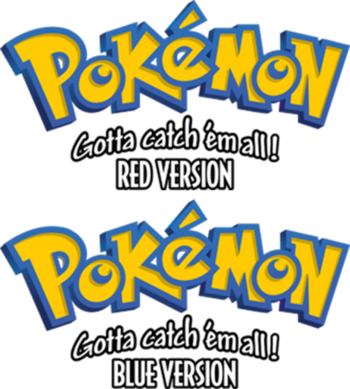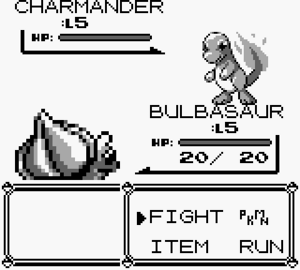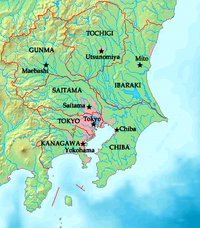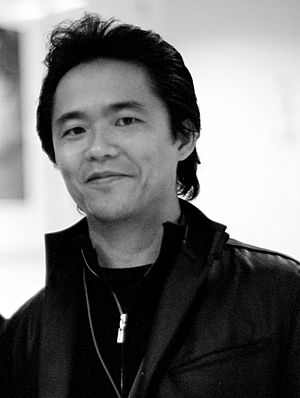Pokémon Red, Blue, and Yellow facts for kids
Quick facts for kids
|
|
|---|---|

The logos used on the front of the US boxes for Pokémon Red and Pokémon Blue
|
|
| Developer(s) | |
| Publisher(s) | Nintendo |
| Director(s) | Satoshi Tajiri |
| Producer(s) |
|
| Designer(s) | Satoshi Tajiri |
| Programmer(s) |
|
| Artist(s) | |
| Writer(s) |
|
| Composer(s) | Junichi Masuda |
| Series | Pokémon |
| Platform(s) | |
| Release date(s) |
|
| Genre(s) | Role-playing |
| Mode(s) | Single-player, multiplayer |
Pokémon Red Version and Pokémon Blue Version are exciting role-playing video games made by Game Freak and published by Nintendo. They came out for the Game Boy in 1996. These games are the very first ones in the popular Pokémon video game series.
They were first released in Japan as Pocket Monsters Red and Pocket Monsters Green. A special version, Pocket Monsters Blue, came out later that year in Japan. In North America and Australia, these games were released in 1998 as Pokémon Red and Pokémon Blue. Europe got them in 1999.
Pokémon Yellow Version: Special Pikachu Edition, or simply Pokémon Yellow, is an improved version. It was released in Japan in 1998 and in other parts of the world in 1999 and 2000. Later, remakes called Pokémon FireRed and LeafGreen were released for the Game Boy Advance in 2004.
In 2016, Red, Blue, and Yellow (plus Green in Japan) were re-released. You could play them on the Nintendo 3DS Virtual Console service. This was to celebrate the Pokémon series' 20th anniversary.
In these games, you play as a main character from above, like looking down on them. You explore the fictional Kanto region. Your main goal is to become the champion of the Indigo League. To do this, you must beat eight Gym Leaders and then the four best Pokémon trainers, known as the Elite Four.
Another big goal is to complete the Pokédex. This is like an in-game encyclopedia. You fill it by catching all 151 different Pokémon. Red and Blue let you use a Game Link Cable. This cable connects two Game Boy systems. It allows players to trade Pokémon or battle each other. Both games have the same story. However, you need to trade between them to get all 151 original Pokémon.
Red and Blue were very popular with critics. They especially liked the multiplayer options, like trading Pokémon. The games scored 89% on GameRankings. Many people consider them among the greatest games ever made. They have been on IGN's "Top 100 Games of All Time" list for many years. These games started a huge franchise that has sold over 300 million copies. In 2009, IGN called them the "Best selling RPG on the Game Boy" and "Best selling RPG of all time".
Contents
Playing the Game: How to Play Pokémon
Pokémon Red and Blue are played from a third-person view, looking down from above. The game has three main screens. First, there's the overworld, where you move your character around. Second, there's a side-view battle screen. Third, there's a menu where you can manage your Pokémon, items, or game settings.
You use your Pokémon to battle other Pokémon. When you meet a wild Pokémon or a trainer challenges you, the screen changes. It becomes a turn-based battle screen showing the two Pokémon fighting. During a battle, you can choose one of four moves. You can also use an item, switch your active Pokémon, or try to run away. Running away is not possible in trainer battles.
Pokémon have hit points (HP). If a Pokémon's HP drops to zero, it faints. It cannot battle again until it is revived. When an enemy Pokémon faints, your Pokémon that fought get experience points (EXP). After getting enough EXP, your Pokémon will level up. A Pokémon's level affects its strength and the moves it learns. Some Pokémon can also evolve at certain levels. Evolution changes their stats and how they learn new moves.
Catching Pokémon is a key part of the game. When battling a wild Pokémon, you can throw a Poké Ball. If you succeed, the Pokémon becomes yours. How easy it is to catch a Pokémon depends on its HP, if it has a status effect (like sleep), and the type of Poké Ball. Lower HP and stronger Poké Balls make it easier. The main goal is to complete your Pokédex. You do this by catching, evolving, and trading to get all 151 creatures.
Trading and Connecting with Other Games
Pokémon Red and Blue let players trade Pokémon between two game cartridges. You do this using a Game Link Cable. Trading is needed to complete the Pokédex. Some Pokémon only evolve when traded. Also, each game has Pokémon that are only found in that version. The Link Cable also lets you battle another player's Pokémon team.
When playing Red or Blue on a Game Boy Advance or SP, you need a special Nintendo Universal Game Link Cable. The standard GBA/SP link cable won't work. Also, the English versions of the games cannot trade with the Japanese versions. This is because they use different languages and could corrupt your save files.
You can trade Pokémon between Red, Blue, and Yellow. You can also trade with the second generation of Pokémon games: Pokémon Gold, Silver, and Crystal. However, there are some limits. The games can't link if one player has Pokémon or moves from the second generation. You can also use the Transfer Pak with the Nintendo 64. This lets you use Pokémon and items from Red and Blue in the Nintendo 64 games Pokémon Stadium and Pokémon Stadium 2.
Game Glitches and Secrets
Pokémon Red and Blue are known for having many glitches. This might be because the game was very big for its time. One famous glitch lets you find MissingNo. (short for "Missing Number"). This is a glitch Pokémon with different forms. You can also find other Pokémon using glitches, like the rare Mythical Pokémon Mew, which was not meant to be found normally. Another glitch, called the "EXP underflow glitch," can help you quickly level up your Pokémon.
The Story and Where it Happens
Your Adventure in Kanto
Your adventure starts in your hometown, Pallet Town. When you walk into the tall grass alone, Professor Oak stops you. He is a famous Pokémon researcher. Professor Oak tells you that wild Pokémon live there and it's dangerous to go alone. He takes you to his lab. There, you meet Oak's grandson, who is also a Pokémon Trainer.
You and your rival must choose a starter Pokémon for your journey. You can pick Bulbasaur, Squirtle, or Charmander. Oak's grandson will always choose the Pokémon that is strong against yours. He will then challenge you to a Pokémon battle. He will keep battling you at different points throughout the games.
As you visit cities, you'll find special buildings called Gyms. Inside are Gym Leaders. You must defeat each Gym Leader in a Pokémon battle to earn eight Gym Badges. Once you have all the badges, you can enter the Indigo League. This is where the best Pokémon trainers in the region compete. There, you will battle the Elite Four and finally the new Champion: your rival!
Throughout the game, you will also fight against Team Rocket. They are a criminal group that uses Pokémon for bad things. They try to steal rare Pokémon, and you must stop their plans.
Exploring the Kanto Region
Pokémon Red and Blue are set in the Kanto region. This region is based on the real-life Kantō region in Japan. Kanto has different places where the 151 Pokémon species live. It also has towns and cities where people live, connected by Routes. Some areas can only be reached after you learn a special ability or get a special item.
Kanto has many towns: Pallet Town, Viridian City, Pewter City, Cerulean City, Vermillion City, Lavender Town, Celadon City, Fuchsia City, Saffron City, Cinnabar Island, and the Indigo Plateau. Most of these towns have a Gym with a leader to battle. The battles against the Elite Four and your rival happen at the Indigo Plateau. You can catch Pokémon in many places, like caves (Mt. Moon, Rock Tunnel) or the sea. For example, Tentacool are found in water, while Zubat are found in caves.
Making the Games: How Pokémon Was Created
The game creator, Satoshi Tajiri, first shared his idea for Pokémon with Nintendo in 1990. At first, people were unsure. They thought his ideas were too big and didn't see why it would be fun. But Shigeru Miyamoto, a famous game designer, saw great potential. He convinced Nintendo to go ahead with the project.
The idea for Pokémon came from Tajiri's childhood hobby of insect collecting. As he grew up, his town became more developed, and insects became harder to find. Tajiri noticed kids were playing indoors more. He thought of a video game with creatures like insects, called Pokémon. He wanted kids to connect with these Pokémon by naming them and controlling them. He also made sure Pokémon never bled or died in battle, only fainted. He didn't want to add more "pointless violence" to games.
When the Game Boy came out, Tajiri thought it was perfect for his idea. Especially because of the link cable. He imagined players trading Pokémon with each other using this cable. This idea of trading information was new for video games. Before, cables were only used for competition. Shigeru Miyamoto suggested making different game cartridges with different Pokémon. This would encourage trading.
The main characters were named after Tajiri himself (as Satoshi) and his friend and mentor, Shigeru Miyamoto (as Shigeru). Ken Sugimori, an artist and Tajiri's friend, led the design of the Pokémon. A small team helped create the designs for all 151 Pokémon. Atsuko Nishida designed Pikachu, Bulbasaur, Charmander, Squirtle, and many others. Sugimori then finalized each design.
The music for the game was made by Junichi Masuda. He used the Game Boy's four sound channels for melodies, sound effects, and Pokémon "cries." He said the game's opening theme, "Monster," was made to sound like battle music.
The game was first called Capsule Monsters. Its name changed a few times due to trademark issues. It became CapuMon and KapuMon before finally being called Pocket Monsters. Tajiri thought Nintendo might reject his game. But the games became a huge success, which surprised both Tajiri and Nintendo. This was especially true because the Game Boy was becoming less popular.
Tajiri said the Poké Ball idea came from Ultraseven (1967–1968). Nintendo spent $13 million to market Pokémon Red and Blue in the United States.
Game Music
Junichi Masuda created the music for the games at his home. He used a Commodore Amiga computer. He then converted the music to work on the Game Boy.
Game Release and Special Versions
In Japan, Pocket Monsters Red and Green were the first versions. They were finished by October 1995. They were supposed to come out on December 21, 1995, but were delayed until February 27, 1996. This was because other related products weren't ready. After a slow start, they sold very well.
A few months later, Pocket Monsters Blue was released in Japan. It was a special edition for CoroCoro Comic subscribers on October 15, 1996. It later came out in stores on October 10, 1999. This version had updated artwork and new dialogue. The code, script, and artwork from the Japanese Blue were used for the international releases of Red and Green. These were renamed Red and Blue. The Japanese Blue game had almost all Pokémon from Red and Green. However, some Pokémon were only in the original editions.
To make the games more exciting, Tajiri hid an extra Pokémon called Mew. He believed this "created a lot of rumors and myths" and "kept the interest alive." Mew was added by Shigeki Morimoto as a joke and wasn't meant to be found by players. Later, Nintendo decided to give out Mew at special events. But in 2003, a glitch became well-known. This glitch allowed anyone to get the rare Mew.
When Pokémon was brought to North America, a small team renamed the Pokémon for Western audiences. They based the new names on the Pokémon's looks and features. Nintendo also trademarked all 151 Pokémon names. This made sure they were unique to the franchise. It was found that simply changing the Japanese text to English was not possible. The games had to be reprogrammed almost from scratch. This was because the original code was complex from the long development time. So, the Western games were based on the more modern Japanese Blue version. They used its programming and artwork. But they kept the same Pokémon distribution as the Japanese Red and Green cartridges.
Nintendo reportedly spent over $50 million to promote Red and Blue in the US. They worried American children might not like the "cute monsters." The Western team suggested redesigning the monsters to be "beefed-up." But Nintendo's president, Hiroshi Yamauchi, refused. He saw it as a challenge. Despite these worries, the reprogrammed Red and Blue games with their original designs came out in North America on September 28, 1998. This was over two and a half years after they first appeared in Japan. The games were a huge hit with foreign audiences. Pokémon became a very successful franchise in America. The same versions were released in Australia later in 1998 and in Europe on October 5, 1999.
Pokémon Yellow Edition
Two years after Red and Green, Nintendo released Pokémon Yellow. This was an improved version of Red and Blue. It came out in Japan in 1998, and in North America and Europe in 1999 and 2000. This game was made to look like the Pokémon TV show. In Yellow, you get a Pikachu as your first Pokémon, and your rival starts with an Eevee. Some characters in the game look like those from the anime, including Team Rocket's Jessie and James.
Pokémon Yellow changed and improved many things from the original games. Your starter Pokémon is only Pikachu. This Pikachu also has a voice and a unique personality. It follows you around in the game world. You can turn around and talk to it. Pikachu's happiness depends on your actions. Leveling it up makes it happy, but if it faints often, it becomes unhappy. This feature was used again in Pokémon HeartGold and SoulSilver and Pokémon: Let's Go, Pikachu! and Let's Go, Eevee!.
Yellow also has a "Pikachu's Beach" minigame. You could only play it if you won a Nintendo contest or completed a challenge in Pokémon Stadium. You would then exchange data using the Transfer Pak. Yellow had slightly better graphics than Red and Blue. It could also print Pokédex entries onto stickers using the Game Boy Printer.
Pokémon Yellow was made by Game Freak. Its development started after the Japanese Pokémon Blue was finished. Work on Pokémon Yellow happened at the same time as the long development of Pokémon Gold and Silver. Pokémon Yellow was released to go along with Pokémon: The First Movie. It came out in Japan on September 12, 1998, in Australia on September 3, 1999, in North America on October 19, 1999, and in Europe on June 16, 2000. Nintendo published it. A special Pikachu-themed Game Boy Color bundle was released in North America in October 1999. To promote Pokémon Yellow, Volkswagen and Nintendo made a yellow Volkswagen New Beetle inspired by Pikachu.
Re-releases for Modern Systems
On February 27, 2016, Nintendo re-released Red, Blue, and Yellow for the Nintendo 3DS Virtual Console service. This was for the 20th anniversary of the first Pokémon games in Japan. These re-releases had a new feature for the Virtual Console: simulated Link Cable functions. This allowed trading and battling between games. Like its original release, Green was only available in Japan. These versions could also transfer Pokémon to Pokémon Sun and Moon using the Pokémon Bank app.
Special Nintendo 2DS bundles were released in Japan, Europe, and Australia on February 27, 2016. Each console matched the color of a game version. North America got a special New Nintendo 3DS bundle with cover plates designed like Red and Blue's box art. By March 31, 2016, these re-releases sold 1.5 million copies. More than half of them were sold in North America.
The Legacy of Pokémon Red and Blue
The website 1UP.com listed Red and Blue as one of the "Top 5 'Late to the Party' Games." These are games that showed a gaming platform's hidden potential and were among the last released for their console. Red and Blue were ranked first. They were called Nintendo's "secret weapon" for the Game Boy in the late 1990s. The games' success brought new life to the Game Boy.
Nintendo Power listed Red and Blue as the third best Game Boy and Game Boy Color games. They said something about the games made them keep playing until they caught every Pokémon. Game Informer's Ben Reeves called them (along with Pokémon Yellow, Gold, Silver, and Crystal) the second best Game Boy games. He said they had more depth than they seemed. Official Nintendo Magazine named them one of the best Nintendo games ever, placing them 52nd on their top 100 list.
Red and Blue were number 72 on IGN's "Top 100 Games of All Time" in 2003. Reviewers noted that the games "started a revolution." They praised the deep game design and complex strategy, as well as the trading option. Two years later, they moved up to number 70 on the updated list. The games' legacy was noted for inspiring many video game sequels, movies, TV shows, and other merchandise. This made them a strong part of popular culture. In 2019, PC Magazine included the games on their "The 10 Best Game Boy Games." In 2023, Time Extension put the game on their "Best JRPGs of All Time" list. In 2007, Red and Blue were ranked at number 37 on the list.
These games are widely recognized for starting and helping the successful multibillion-dollar Pokémon series. Five years after Red and Blue's first release, Nintendo celebrated its "Pokémonniversary." George Harrison, a senior vice president at Nintendo of America, said that "those precious gems [Pokémon Red and Blue] have evolved into Ruby and Sapphire." He added that new Pokémon adventures would be released soon. The series has since sold over 300 million games. This success is all thanks to the huge popularity of the original Red and Blue versions.
On February 12, 2014, an anonymous programmer launched Twitch Plays Pokémon. This was a "social experiment" on the video streaming website Twitch. Many people worked together to play a modified version of Pokémon Red. They typed commands into the channel's chat, with about 50,000 viewers playing at once. The game was finished on March 1, 2014. It had 390 hours of continuous gameplay controlled by many users.
In 2017, The Strong National Museum of Play added Pokémon Red and Green to its World Video Game Hall of Fame.
Newer Versions: Remakes of the Originals
Pokémon FireRed Version and Pokémon LeafGreen Version are improved enhanced remakes of Pokémon Red and Blue. Game Freak developed these new games, and Nintendo published them for the Game Boy Advance. They could connect with the Game Boy Advance Wireless Adapter, which came with the games. However, these games are not compatible with older Pokémon versions. This is because FireRed and LeafGreen added new features, like changing the "Special" stat into "Special Attack" and "Special Defense."
FireRed and LeafGreen were first released in Japan on January 29, 2004. They came out in North America on September 9 and in Europe on October 1, 2004. They received great reviews, scoring 81% on Metacritic. Most critics liked that the games added new features while keeping the classic gameplay. The graphics and audio got mixed reviews. Some thought they were too simple and not much better than the previous games, Pokémon Ruby and Sapphire. FireRed and LeafGreen were very successful, selling about 12 million copies worldwide.
Pokémon: Let's Go, Pikachu! and Pokémon: Let's Go, Eevee! are updated remakes of Pokémon Yellow Version. They were released in November 2018 for the Nintendo Switch. These games were made for new players of the Pokémon series. They include features from Pokémon Go. The games take place in the Kanto region and only feature the original 151 Pokémon.
In these games, your Pokémon can follow you in the overworld. This feature was last seen in Pokémon HeartGold and SoulSilver on the Nintendo DS. In Let's Go, Pikachu! or Let's Go, Eevee!, your starter Pikachu or Eevee will always follow you. These games have sold over 13 million copies worldwide.
See also
 In Spanish: Pokémon rojo y Pokémon azul para niños
In Spanish: Pokémon rojo y Pokémon azul para niños





